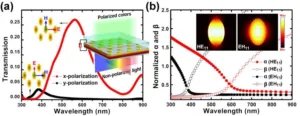Long Wen, a researcher at the Suzhou Institute of Nano-Tech and Nano-Bionics, Chinese Academy of Sciences and his colleagues, are suggesting a new type of backlight to increase the power efficiency of LCD modules. They are discussing an energy recycling scheme to create colored polarized light without the use of color filters.
Most modern mobile devices are, to a certain degree, power limited. While it is almost impossible to point a finger at any one specific component that limits battery life the most, the typical components under observation are CPU, GPU, camera and of course the display panel. As power consumption by component varies according to the application and use mode, some measurements indicate that modern displays LCD or OLED seem to consume about one quarter to one third of the total power consumption. Therefore, lowering the power consumption in the display unit is definitely beneficial.
Long Wen and the group of Chinese researchers point out that a large amount of the light produced in the backlight gets absorbed in the polarization and color filters, ending up as heat dispersed into the environment. Their estimate shows that only 5% to 10% of the energy used to power the backlight actually reaches the eye in form of light. They suggest changing that by creating a new structure in the display that does not absorb the light as filters do, but convert them back to electric energy that can drive the light source in the backlight.
To accomplish this task, they are combining metal electrodes embedded in an organic PV material to achieve a light output of polarized colored light. The polarizer works in a similar way to a wire grid polarizer by creating elliptical nano-holes in the rear electrode that provide the desired polarization of the light. As with wire grid polarizers, the other light is rejected back into the backlight where it can be recycled.
The holes are designed to let only certain wavelengths pass through, creating a type of color filter. The PV material function layers act as additional color filters, further narrowing the bandwidth of the passing light. The following chart shows the results of such a device.
Source: Polarizing colour filters for power-saving display
It is not clear if this is actually the result of a functioning device or just mathematical simulation. The PV material absorbs light outside of the desired wavelength and returns it as an electric current.
Analyst Comment
The idea is certainly intriguing as it could lower the overall power consumption. There is, of course, the question of conversion efficiency in organic PV materials and the additional cost of creating such a backlight filter. Nevertheless, it shows that LCD research is still far from reaching a plateau of wisdom and new ideas, making it so much more difficult for OLED to take over the display business any time soon. – NH

